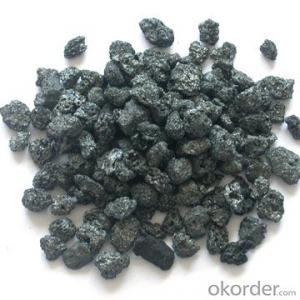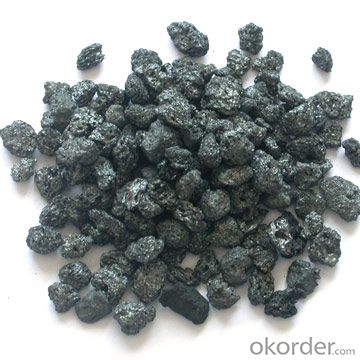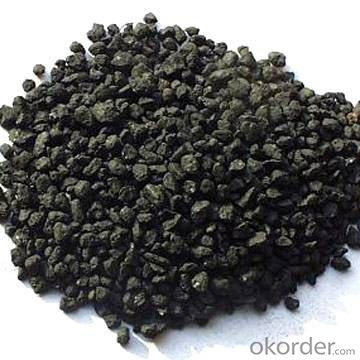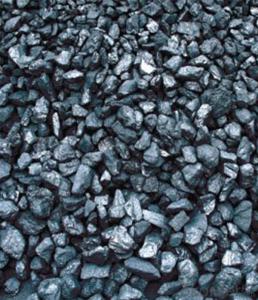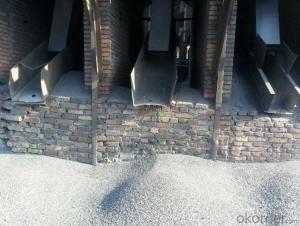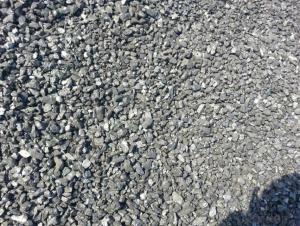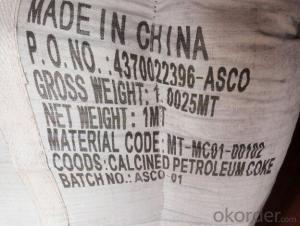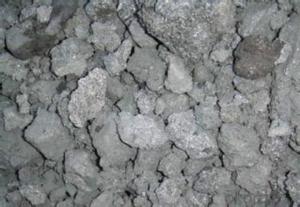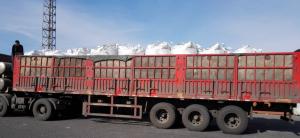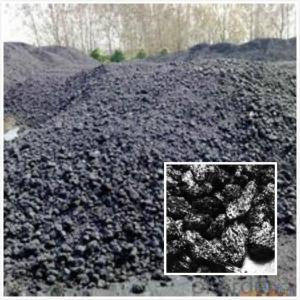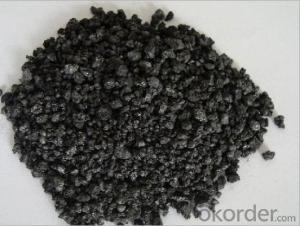Calcined Petroleum Coke with 98.5 Carbon
- Loading Port:
- Tianjin
- Payment Terms:
- TT OR LC
- Min Order Qty:
- 1 m.t.
- Supply Capability:
- 10000000 m.t./month
OKorder Service Pledge
OKorder Financial Service
You Might Also Like
1.Structure of Calcined Petroleum Coke Description
Calcined Petroleum Coke is made from raw petroleum coke,which is calcined in furnace at a high temperature(1200-1300℃).CPC/Calcined Petroleum Coke is widely used in steelmaking,castings manufacture and other metallurgical industry as a kind of recarburizer because of its high fixed carbon content,low sulfur content and high absorb rate.Besides,it is also a best kind of raw materials for producing artifical graphite(GPC/Graphitized Petroleum Coke) under the graphitizing temperature(2800℃).
2.Main Features of the Calcined Petroleum Coke
High-purity graphitized petroleum coke is made from high quality petroleum coke under a temperature of 2,500-3,500°C. As a high-purity carbon material, it has characteristics of high fixed carbon content, low sulfur, low ash, low porosity etc.It can be used as carbon raiser (Recarburizer) to produce high quality steel,cast iron and alloy.It can also be used in plastic and rubber as an additive.
3. Calcined Petroleum Coke Images
4. Calcined Petroleum Coke Specification
| Place of Origin: | China (Mainland) | Type: | Petroleum Coke | Sulphur Content (%): | 0.5 |
| Ash Content (%): | 1 | Fixed Carbon (%): | 98.5 | Moisture (%): | 1 |
| Volatile Matter (%): | 0.5 | Brand Name: | CNBM | Model Number: | 98.5 CPC |
| function: | steel-making and founding as a kind of car |
5.FAQ of Calcined Petroleum Coke
1). Q: Are you a factory or trading company?
A: We are a factory.
2). Q: Where is your factory located? How can I visit there?
A: Our factory is located in ShanXi, HeNan, China. You are warmly welcomed to visit us!
3). Q: How can I get some samples?
A: Please connect me for samples
4). Q: Can the price be cheaper?
A: Of course, you will be offered a good discount for big amount.
- Q: How does carbon impact the stability of desert ecosystems?
- Carbon can have both positive and negative impacts on the stability of desert ecosystems. On one hand, carbon is an essential element for all living organisms and is a key component of organic matter. It plays a crucial role in the processes of photosynthesis, respiration, and decomposition, which are vital for the survival and growth of plants and other organisms in deserts. Carbon dioxide, a form of carbon, is taken in by plants during photosynthesis to produce glucose and oxygen, providing the necessary energy for their growth. This promotes the stability of desert ecosystems by supporting primary productivity and the food web. However, the excessive release of carbon into the atmosphere, primarily through human activities such as burning fossil fuels and deforestation, has led to an increase in greenhouse gases, including carbon dioxide. This leads to global warming and climate change, which have significant negative impacts on desert ecosystems. Rising temperatures can alter the delicate balance of desert ecosystems, affecting the distribution and abundance of plant and animal species. Some plants may struggle to adapt to the changing climate, while others may benefit, leading to shifts in species composition and potential loss of biodiversity. Moreover, increased carbon dioxide levels can also affect the water availability in desert ecosystems. Elevated carbon dioxide levels can result in increased water-use efficiency in plants, allowing them to conserve water. This can be beneficial in water-limited environments like deserts, as it helps plants to survive under drought conditions. However, this can also lead to changes in water dynamics, impacting the availability of water resources for other organisms in the ecosystem. In summary, carbon is essential for the stability of desert ecosystems as it supports primary productivity and the functioning of food webs. However, the excessive release of carbon into the atmosphere contributes to climate change, which negatively impacts desert ecosystems by altering species distribution, reducing biodiversity, and affecting water availability. It is crucial to mitigate carbon emissions and promote sustainable practices to ensure the long-term stability and resilience of desert ecosystems.
- Q: Appearance, hardness, electrical conductivity, use of carbon 60
- C60 is a molecule composed of 60 carbon atoms in the molecule, it is like football, so also known as footballene (C60. This material is composed of C60 molecules, rather than by the atoms.) C60 is simply made of carbon atoms with stable molecules, it has 60 vertices and 32 sides. The 12 is Pentagon and 20 hexagon. Its molecular weight is about 720.
- Q: What are the impacts of carbon emissions on the stability of coastal areas?
- Carbon emissions have significant impacts on the stability of coastal areas, posing various challenges to the environment and communities residing in these regions. One of the most prominent impacts is sea-level rise, caused by the melting of polar ice caps and thermal expansion of seawater due to rising global temperatures. As carbon dioxide and other greenhouse gases accumulate in the atmosphere, they trap heat, leading to the warming of the planet. This, in turn, causes glaciers and ice sheets to melt, contributing to the rising sea levels. Sea-level rise poses a direct threat to coastal areas, resulting in increased erosion, coastal flooding, and the loss of valuable land. As water levels rise, the shoreline retreats, eroding beaches and cliffs, and endangering coastal infrastructure and habitats. This erosion not only threatens the stability of coastal ecosystems but also puts human settlements at risk, leading to the displacement of communities and loss of property. Moreover, the increase in carbon emissions leads to ocean acidification, whereby the excess carbon dioxide is absorbed by the ocean, resulting in a decrease in its pH levels. Acidic waters have detrimental effects on marine life, including coral reefs, shellfish, and other marine organisms that rely on calcium carbonate for their shells and skeletons. As the acidity of the ocean increases, these organisms struggle to form and maintain their protective structures, leading to the degradation of coastal ecosystems and the loss of biodiversity. Another impact of carbon emissions on coastal areas is the intensification of extreme weather events, such as hurricanes and tropical storms. Warmer ocean temperatures provide more energy for these storms, making them more powerful and destructive. These events can cause extensive damage to coastal infrastructure, including buildings, roads, and utility systems. Furthermore, they can result in the loss of lives and livelihoods, exacerbating the vulnerability of coastal communities. In summary, carbon emissions have far-reaching impacts on the stability of coastal areas. Sea-level rise, ocean acidification, and intensified extreme weather events all contribute to the degradation of coastal ecosystems, loss of biodiversity, erosion, and coastal flooding. These impacts not only threaten the environment but also pose significant risks to human settlements, requiring urgent mitigation and adaptation measures to protect coastal areas and the communities that rely on them.
- Q: What is carbon black ink?
- Carbon black ink is a type of ink that is made by dispersing carbon black pigment in a liquid medium. It is commonly used in printing and writing applications due to its deep black color and high opacity.
- Q: How do you remove the carbon stains on your clothes?
- 1, first pour alcohol on clothes, fountain pen scratches, every scratch should be evenly covered with alcohol, alcohol should be used at a concentration of not less than 75% of the medical alcohol.2, pour the clothes down, put this side of the alcohol up, try not to touch other surfaces of the clothes, otherwise, the color of the pen or ballpoint pen may be stained with other parts of the clothes.3, with ordinary washbasin, ready most of the basin of water, and then will be full of two bottles of bleach water poured in the water, pay attention to must be full two bottle cap.4, take a stir, and then add a little washing powder, this amount can be mastered.5, after a little mixing, so that washing powder can be fully dissolved in water. Well, now soak your clothes in water for twenty minutes.
- Q: How does carbon affect the fertility of soil?
- Carbon is an essential element for soil fertility as it influences various soil properties and processes. When carbon is added to the soil, it helps improve its structure and water holding capacity. Organic matter, which is rich in carbon, serves as a food source for microorganisms, which in turn promote nutrient cycling and soil aggregation. These microorganisms break down organic matter into simpler compounds, releasing essential nutrients that are readily available for plants. Additionally, carbon also acts as a sponge, holding onto nutrients like nitrogen and preventing their leaching, thus enhancing nutrient availability for plants. Moreover, carbon-rich soils tend to have a higher cation exchange capacity, which means they can retain and release nutrients more effectively. By maintaining and increasing soil carbon levels, we can enhance soil fertility, promote plant growth, and support sustainable agriculture practices.
- Q: What is carbon pricing?
- Carbon pricing refers to a policy mechanism that aims to reduce greenhouse gas emissions by assigning a monetary value to carbon dioxide and other greenhouse gas emissions. It essentially puts a price on the carbon content of fossil fuels and other activities that release greenhouse gases into the atmosphere. The main objective of carbon pricing is to incentivize businesses, industries, and individuals to reduce their carbon emissions by making it more economically viable to adopt cleaner and more sustainable practices. There are two primary methods of carbon pricing: carbon taxes and cap-and-trade systems. A carbon tax sets a fixed price per ton of carbon emissions, which businesses and industries must pay based on their emissions levels. This tax creates a financial incentive for companies to reduce their emissions to avoid higher costs. On the other hand, cap-and-trade systems set a limit, or cap, on the total amount of emissions allowed in a given period. Companies are then allocated a certain number of emissions permits, which they can buy, sell, or trade with other companies. This system creates a market for emissions, where companies that can reduce their emissions more easily can sell their surplus permits to those struggling to meet their targets. The revenue generated from carbon pricing can be used in various ways. It can be reinvested into renewable energy projects, energy efficiency initiatives, or research and development of clean technologies. It can also be used to support vulnerable communities affected by the transition to a low-carbon economy or to offset the economic impacts on industries that may face challenges in reducing their emissions. Carbon pricing is considered an effective tool for tackling climate change, as it provides a clear economic signal to businesses and individuals to reduce their carbon footprint. By placing a price on carbon, it internalizes the costs associated with climate change and encourages the adoption of cleaner alternatives. It also helps to level the playing field between polluting industries and those investing in low-carbon technologies, creating an incentive for innovation and the development of sustainable practices.
- Q: What are the problems that should be paid attention to in the injection molding of the material? Who has some details about carbon fiber injection? Thank you for sharing
- Carbon fiber melting point at about 3000 degrees (isolation oxygen, oxygen, about 400 degrees will be oxidized), itself can not be injection processing, only carbon fiber filled plastic can be injection molding.
- Q: The victory of the lightning 3361 material is full of carbon fiber, and the 3363 is made of carbon fiber and resin, which is better??
- HelloThese two rackets are a good choice for beginners, and the price is almost the same. In theory, of course, the resin + carbon fiber is better. Carbon fiber increases the hardness of the racket, while the resin increases the toughness of the racket. Therefore, this kind of racket is softer than the center pole, suits the defensive and the ball control type. However, 3363 people as a basic racket, is not on the resin have too many requirements, as mentioned above, the content of resin may be less than 5%, which is why the two price is almost the sake of racket.My suggestion is that the landlord to buy carbon fiber 3361, first, this time longer, very popular, reputation has been good, two is 3363, some people feel too soft, the ball is not far away, with a very uncomfortable feeling. Of course, it depends on the characteristics of the landlord himself.I hope that the answer can help to you, I hope you join our team "badminton kingdom", to create our own kingdom of badminton!
- Q: What are the impacts of carbon emissions on the stability of islands?
- Carbon emissions have significant impacts on the stability of islands. The primary consequence is the rise in sea levels due to global warming, leading to increased coastal erosion and flooding. Additionally, carbon emissions contribute to ocean acidification, threatening marine ecosystems that islands heavily depend on for livelihoods and food security. Moreover, the warming climate intensifies extreme weather events like hurricanes, posing a greater risk to island communities. Overall, carbon emissions destabilize islands both environmentally and economically, making them highly vulnerable to the impacts of climate change.
Send your message to us
Calcined Petroleum Coke with 98.5 Carbon
- Loading Port:
- Tianjin
- Payment Terms:
- TT OR LC
- Min Order Qty:
- 1 m.t.
- Supply Capability:
- 10000000 m.t./month
OKorder Service Pledge
OKorder Financial Service
Similar products
Hot products
Hot Searches
Related keywords

